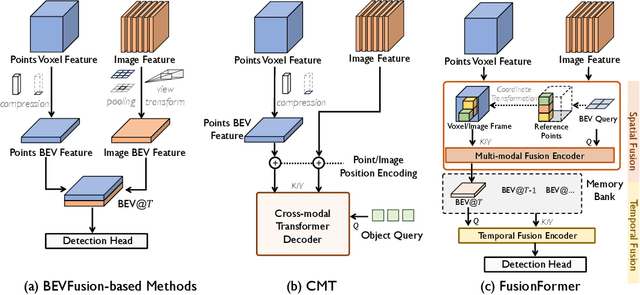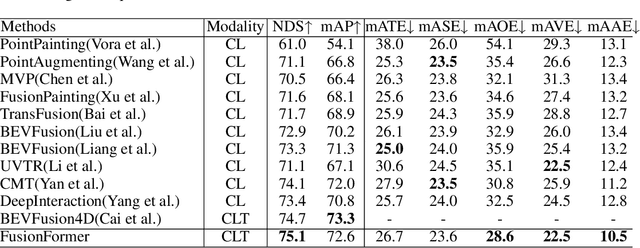Chunyong Hu
FusionFormer: A Multi-sensory Fusion in Bird's-Eye-View and Temporal Consistent Transformer for 3D Objection
Sep 11, 2023



Abstract:Multi-sensor modal fusion has demonstrated strong advantages in 3D object detection tasks. However, existing methods that fuse multi-modal features through a simple channel concatenation require transformation features into bird's eye view space and may lose the information on Z-axis thus leads to inferior performance. To this end, we propose FusionFormer, an end-to-end multi-modal fusion framework that leverages transformers to fuse multi-modal features and obtain fused BEV features. And based on the flexible adaptability of FusionFormer to the input modality representation, we propose a depth prediction branch that can be added to the framework to improve detection performance in camera-based detection tasks. In addition, we propose a plug-and-play temporal fusion module based on transformers that can fuse historical frame BEV features for more stable and reliable detection results. We evaluate our method on the nuScenes dataset and achieve 72.6% mAP and 75.1% NDS for 3D object detection tasks, outperforming state-of-the-art methods.
FusionAD: Multi-modality Fusion for Prediction and Planning Tasks of Autonomous Driving
Aug 14, 2023



Abstract:Building a multi-modality multi-task neural network toward accurate and robust performance is a de-facto standard in perception task of autonomous driving. However, leveraging such data from multiple sensors to jointly optimize the prediction and planning tasks remains largely unexplored. In this paper, we present FusionAD, to the best of our knowledge, the first unified framework that fuse the information from two most critical sensors, camera and LiDAR, goes beyond perception task. Concretely, we first build a transformer based multi-modality fusion network to effectively produce fusion based features. In constrast to camera-based end-to-end method UniAD, we then establish a fusion aided modality-aware prediction and status-aware planning modules, dubbed FMSPnP that take advantages of multi-modality features. We conduct extensive experiments on commonly used benchmark nuScenes dataset, our FusionAD achieves state-of-the-art performance and surpassing baselines on average 15% on perception tasks like detection and tracking, 10% on occupancy prediction accuracy, reducing prediction error from 0.708 to 0.389 in ADE score and reduces the collision rate from 0.31% to only 0.12%.
 Add to Chrome
Add to Chrome Add to Firefox
Add to Firefox Add to Edge
Add to Edge